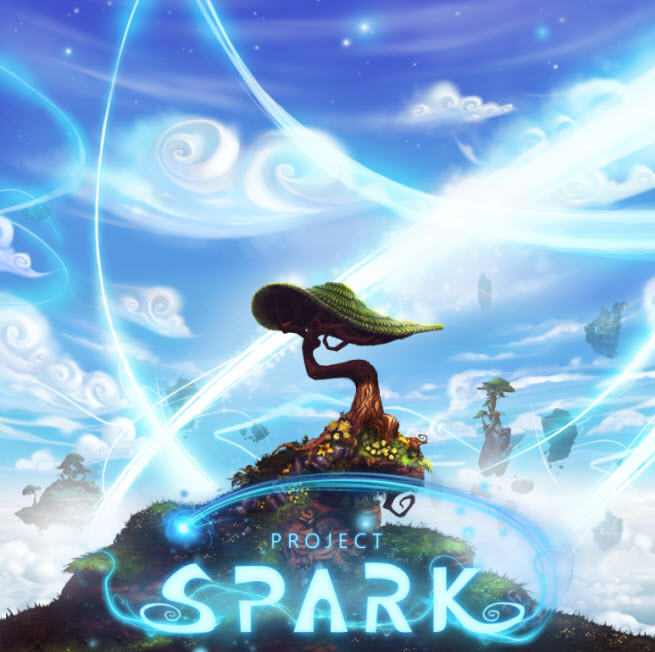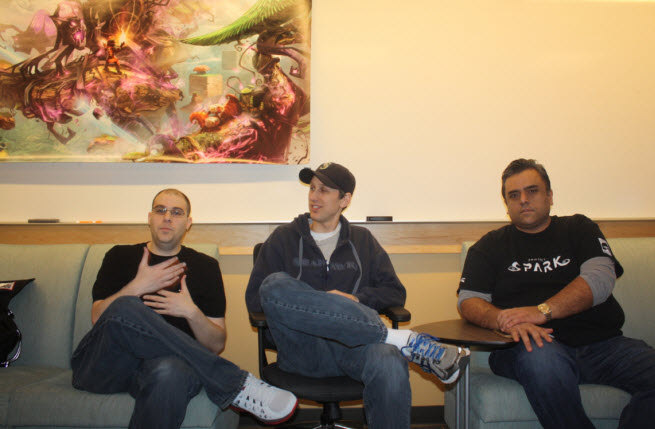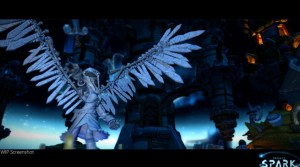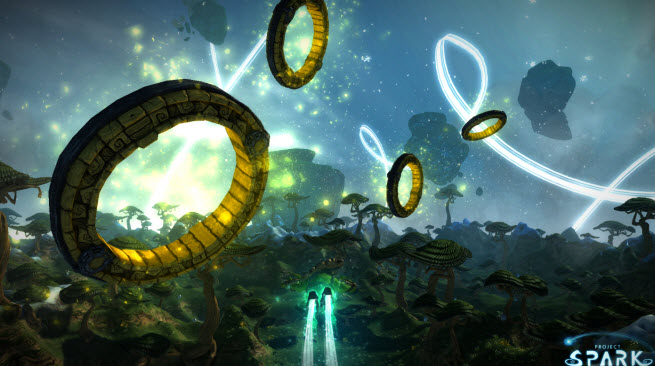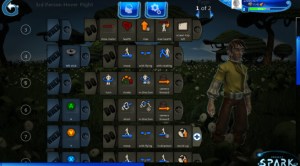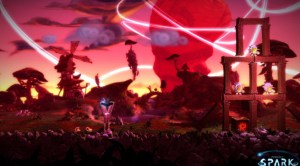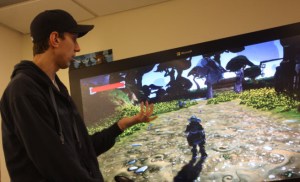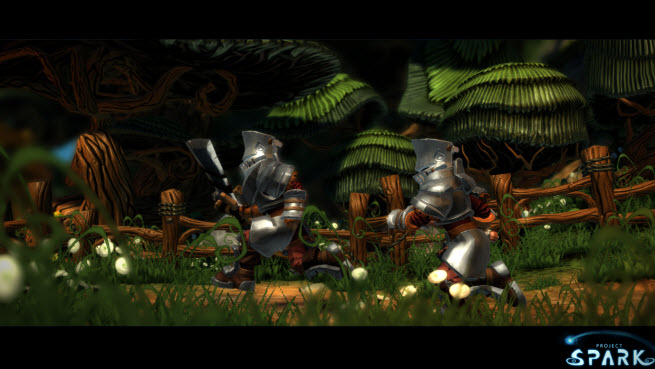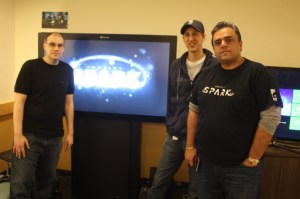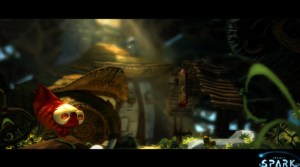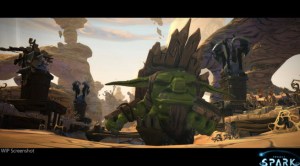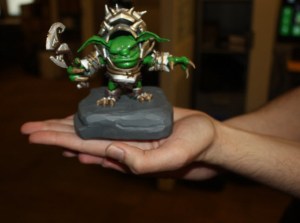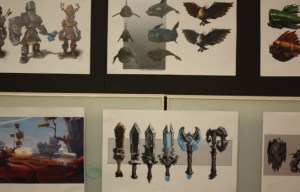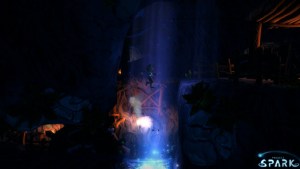REDMOND, Wash. — Hidden in a business park amid some beautiful woods, Microsoft has built a pretty nest for Team Dakota and its next big game for the Xbox One, Windows, and Xbox 360: Project Spark.
Project Spark is Microsoft’s big bet to create a user-generated community akin to Minecraft, LittleBigPlanet, or Second Life, where the players themselves create and share their own game characters, game worlds, and objects. It is part of the movement to create a sharing economy where the users can sustain a game by producing far more content than the game developers themselves can.
With Project Spark, you will be able to use anything from a standard PC to a huge touchscreen television to build your own video game. You can plant an entire landscape of woods with the sweep of your hand and create your own character in real time, with no delays usually associated with creative software. Microsoft hopes that it can inspire a whole generation of people to become creators, even if they never had any programming experience at all. The game is in closed beta testing now, and players are creating all sorts of cool game worlds, such as Star Wars or Harry Potter fan games.
We visited the headquarters where Team Dakota is putting the finishing touches on Project Spark. We sat down with creative director Henry Sterchi, lead game designer Brad Rebh, and Rahul Sandil, and interactive entertainment industry executive at Team Dakota. Here’s an edited transcript of our conversation. We’ve also added a photo gallery of Team Dakota and Project Spark at the bottom of the story.
GamesBeat: You started about three years ago. What’s the milieu for coming up with this? Minecraft wasn’t that popular at that time. Was it even out?
Henry Sterchi: I don’t think it was out at the time, now.
GamesBeat: But Minecraft established this whole creativity genre in the biggest way possible. There were people who were trying to create things — Second Life — that almost seemed like they required more professional expertise. Somehow, we got from Second Life to Minecraft. What do you think was important there, and how do you take some of these things and learn from them?
Sterchi: Historically, we’re inherently born with the need to create and play. They’re natural tendencies in us. When you think about grounding it from there — you look at that concept and say, “Everyone wants to play and wants to create.” We had an opportunity to do some blue sky investigations, and we pivoted straight toward that. What does it mean to play? What we saw was, if you think about a kid playing, they run around their neighborhood. They tell stories. They go on adventures.
You look at the modern day and … now they’re sitting in front of a television. They’re having media given to them. When they play games, they go from left to right. They don’t have that opportunity to make their own adventures. So we started exploring that. We looked at everything from Lincoln Logs to play behavior in general. We started thinking past video games. That’s when we started thinking about the genesis of this idea.
When you start thinking about the history of this in a video game form, I think you’re right to say that the popularity has increased recently. A lot of bigger hits are becoming more mainstream. But I go way back to things like Pinball Construction Set, like Incredible Machine, things that gamified creation back then.
GamesBeat: Things like SimCity.
Sterchi: SimCity, yeah. You think about this urge to play and create that’s in us all. These digital blocks, digital architecture types of sets. They’ve been there forever. Right now, we’re seeing a lot of things around STEM [science, technology, engineering, and mathematics], a lot of people interested in programming. We’re seeing programming tools and the ability to create games being more and more accessible. It’s this culmination, this perfect storm around the timing, where it’s something people want to do. They believe they can do it.
If you back up 20 years ago, you’d never imagine that the person performing surgery grew up on Mario. The people that are changing the world right now — presidents and congressmen and figures like that — they grew up on video games. It’s a natural evolution.
GamesBeat: It seems like there’s this continuum from people creating things by coding to people creating things by just moving objects around now.
Sterchi: Exactly. We set out to say, “Look, you need to be able to make a world. You need to be able to put life into that world.” That’s where the code came into it. When you look at all these tools that you’re given, very often you have to play with the rules that are given to you with them. Very often you can’t express yourself entirely.
One of the things we didn’t show is, on Xbox One you can use Kinect to fully motion-capture yourself. These are things that we want to be able to put into the game, to bring people into the game and create their own rules. We’ve had a bunch of kids come in and play this. We had a bunch of adults come in and play. People just put flying on characters and changed their speed and flew around the level for hours. People went and re-created levels from buildings and structures from The Lord of the Rings. We focus on making sure we’re flexible enough to do either of those things.
GamesBeat: You have the two modes. That seems to go to the heart of the problem. In a sandbox world, you have no story. If you’re not a professional story creator, how do you even get started on something that is both your own creation but also has some kind of narrative to it?
Sterchi: We let people come at that from a bunch of directions. One of the core things is, we have a universe. We have Spark. We have some of these characters. We have these starter things. Those Champion characters have some backstory. One of the things that’s important to us is, we provide people with just enough of that foundation that they can take that and create fan fiction, if that’s what they want.
If you look at one of the characters that we picked in the Crossroads mode, that character has a story that leaves it open-ended. People can jump off of that as a springboard for where they want to take their story. If they want to go in and edit their own text, we’ve seen people make Zork types of games, text adventures.
But what we do is, we give them that visual storytelling within the objects that are there. When you look at the characters and you see the sort of things like — the goblins speak for themselves in the way they animate, the way they move. They have a bunch of makeshift objects on them. For their defenses, they have a wooden plank, instead of a real constructed shield. We give people these igniters, these sparks, to tell their stories around what they see and what they hear and what we left them a trail to do.
Brad Rebh: Some people, we’re seeing in the beta, are embracing it and loving it. Other people are like, “No, I have my own idea. Here’s how I’m going to use it.”
GamesBeat: Do you see a bunch of layers here? How creative do you expect your players to be? They don’t want to create blades of grass, but they would love to paint the whole landscape very quickly, so they can finish something fast. But you also don’t want it to be so constrained that they create something and maybe it looks like a thousand other things other people have created with Spark. Is there some deliberate layering built in like that?
Sterchi: Absolutely. If you think about it, it’s very much about peeling the layers of the onion back. At the surface, you can just put down an item. It looks the way we programmed it and drew it to look. Then you can go into it a bit deeper — change the colors or attach objects. We joke about the cabbage. People attach cabbages to people’s heads. They run around and do stuff where their characters have those things on them.
I don’t know if you want to dig into the character creation stuff, but we allow people to change things like skin tone and put these objects on their characters and dive into that.
Rahul Sandil: Someone like me, who’s from more of a business background, I can get into this. I can find something I’ve played before, or that someone has created, and that triggers the inspiration. The questions I can ask are like, “What would this look like with a first-person camera? I can take a side-scrolling game someone has made and, without any programming knowledge, just click on a few buttons and make it into a first-person game. It becomes a whole new game. You can pick any game created in Spark and remix it to make your own thing.
Sterchi: The community has done some fun stuff. One of our inspirations, if you’ve heard of them, there’s a musical group called the Postal Service. It was a sort of indie supergroup that came together via mail and made their own CD.
We have a bunch of tools in our community that allow people to say something like, “Hey, I’m looking for an artist!” or “Hey, I’m looking for programmers.” “Hey, I have this idea, and I need someone to do this part of the game.” In our forums, we have a help-wanted section — a collaboration corner we call it — and people come together like that. People will start to do something, and they’ll get inspired and challenge themselves to take the next step.
If we want to dive into the gamification element of it, one of the things we built into the game is, we give people a sense of progression. The more they do, the more downloads they get, they increase their Spark level. One of the things we’ve included is what we call challenges. We allow people to do these if they want to. We don’t force their hand in any direction. But if you go into the challenges, we have a bunch of things you can do every day.
Go into the goals. You can see we have inspirations in here. We have things like, “Glue some objects together to make something.” We have here, “Spawner” — create this tile to spawn things in your world. If you scroll all the way over to the end, we have a cool multi-step goal for people. “Village Defense.” The first thing you do is you add one of our champions to the world. Then we ask you to add a couple of buildings. Then we ask you to add a couple of enemies. Then we ask you to drop in a couple of turrets. By doing this five-step milestone, you built your own little tower defense game.
GamesBeat: Are there some pretty geeky programming commands that you can ultimately get to?
Sterchi: Absolutely. As you level up, we have trigonometry ones. We have variables and Boolean challenges and stuff like that. We layer those in as you level up. I don’t want to say we give you harder challenges, but definitely deeper ones.
What Rahul said, we’re seeing real evidence of that. It’s encouraging. The community is helping each other. They’re streaming tutorial sessions, or streaming a game and putting it up to let someone else take it and run with it.
GamesBeat: Do they have some commerce options? If they create something and they want to sell it to other players, or if they want to trade things?
Sterchi: Right now, all of this stuff is — we don’t give them actual money or anything like that. But we do have a system where, as we talked about, you can add new elements to the game. It’s free to play. That goes to how we want everyone to be able to create. We wanted to lower that barrier to nothing. So you can go ahead and create with this core set — unlimited, all the stuff.
But what you can do is, as you play and progress you earn credits. You can use those credits to purchase or unlock some of those other content packs we talk about, like the castle. You can play, build up credits, and get the castle for your world. What we do is, in the challenges, we reward people for downloads and uploads and helping each other on the forums. The people that are great creators are making lots of credits, and they’re able to buy more stuff and make cooler things. So we encourage that behavior right now, as opposed to creating a transaction model.
GamesBeat: Is there something that looks like the part people are latching on the most? Is there an activity in the beta that happens the most often?
Sterchi: We have some data. We’re seeing more than 70 percent usage in creating. We’re seeing what we were hoping for – not that five percent you might expect to see creating user-generated content. 70 percent of the time spent in the game is creative. It’s resonating with people.
People ask me a lot about what I’m most excited for. I’m most excited about people creating the unexpected. The barrier to making a new mechanic, making something that’s never been seen before and never been played before, has never been lower. Project Spark facilitates that like nothing else. That’s we’re seeing in the community. We’re seeing game mechanics we’d never thought of. That’s what we’re excited about.
Rebh: What we’re also seeing is that there are certainly the people who come in and say, “I want to make this type of game.” But we also see people who just like to go in there and be creative, not necessarily with a specific objective in mind. They’ll start with the world wizard and build mountains. Then they start dropping in birds. Then they change the brains of the birds to be goblins, so now the birds are attacking them. Before they know it, they start dropping in allies and creating a giant cave. They didn’t have any intent. They’re just having fun using the editor and being creative.
Sterchi: If you think of a linear game, something like Mario, you run, you jump, you bounce off an enemy. Then they give you a harder spot to jump. Then they give you more enemies. That happens naturally throughout, as you’re playing and you’re exploring. You start to say, “Oh, I’ll make a character that jumps.” Then you say, “I want him to double jump.” Then, “I want him to jump higher.” Then, “I want an enemy for him to jump on.” We’re seeing exactly what Brad is saying. They’re naturally progressing.
We’ve seen tons of comments on Twitter already, people saying, “I turned this on and five hours later I’m almost late for work. I got completely immersed in it.” A story just recently came out from someone who reconstructed Fable. People were commenting on the article, and he actually saw it. They were asking him questions, and he was saying, “This is the first level I made. It took me about 20 hours. I did it all with the stuff I started with.” You can see that the people creating have this real connection and this personal story. They’re getting there different ways, on their own terms and at their own pace, but they’re getting there.
Sandil: We’re also seeing a lot of diversity in the demographics. It’s a wide age range, and all ages are represented fully. Grownups and kids and teenagers, men and women.
GamesBeat: Do you feel like you’re delivering something that people aren’t getting from what’s out there?
Sterchi: A lot of the special nature of this comes from how fast you can construct entire worlds, how powerful it can be if that’s how deep you want to go. It’s the ability to create life and behavior. We’ve seen people creating things that react to their own conditions and to their own game constructs. It’s different, in my mind, from what you would historically see, where there’s maybe some sliders you can change to affect a situation, or there’s a character customization option from the game.
You can go in here and create behavior that we never made. We didn’t inherently build this thing into the game, but somebody went and made that. I can’t think of anything else that replicates that right now.
GamesBeat: The giant touchscreen TV seems like a great match for this. The closest thing in the real world might be someone using a tablet with a view of what they’re creating?
Sterchi: That’s a good analogy. We wanted the act of creation to be fun. Being able to touch, to actually see the world sculpting underneath your finger, was a magical thing. This screen is large and impressive, but I’ve created a bunch of stuff on my Surface Pro 2, and I get a lot of that feeling of seeing the world mold behind my finger, through my actions, when I’m on the Surface. But the analogy is on point. Being able to hook that up to a big screen in your living room is probably the most magical moment.
GamesBeat: That’s a SmartGlass extension?
Sterchi: Yeah. It’s something we’ve shown we intend to support from a SmartGlass perspective. But I think it happens even from an asynchronous perspective, too. I created a little blackjack simulator, and I did it all on my Surface Pro. I was able to put that on my TV, on my desktop, on my Xbox One. There’s a pretty magical moment of switching over from whatever game you’re playing on your Xbox One to this thing you just made. You can do that after making it on a touch device.
GamesBeat: Is it clear that at some point, then, the amount of content that’s created is going to far exceed what you guys have created yourselves?
Sterchi: I think it’s already done that. We thought there might be some apprehension. We built in a lot of mechanics around leading you by the hand through your first creation. What we’ve found is that we didn’t need that. People are sharing. They’re screaming at the top of their lungs on their social networks. They’re excited to show their pride of creation to the world.
We do a Twitch stream, and we started by showing what it’s capable of. The first arc we went through was, “What can this do and how can I do it?” When we went to the closed beta and people were making levels, we started focusing on showing the community’s creations. We built an entire feed just for it, what we call all-stars. Those are levels that we’ve played on our feed. The people who created them show up and say, “Look, check it out, play my level!” Then we highlight them on their own feed here.
Sandil: We’ve done some other interesting experiments with Twitch. We take people who’ve never played the game before, like Jessica Shea, who’s the community manager on Halo. We brought her into the Twitch stream and said, “Start building something with us.” Someone who’s never used the tools before, by the time the stream is over, they have a fully functional, playable game. That inspires the community tremendously. It helps them realize, “Oh, I can make something.”
Sterchi: We’ve done collaborations. We built a point-and-click game on a stream we did, about 45 minutes, and let the community tell the story and name the characters and determine the goals and the missions. That’s all up on our Twitch page. It was great, because it was this dynamic collaboration.
GamesBeat: If you were to do something like create a sci-fi version of Project Spark, would that be a huge investment of your team’s time?
Sterchi: We’re trying to strike a balance. Our intention is to provide this as a service. It’s constantly evolving. That comes from on-board features, polishing them and improving on what we have, as well as adding new functionality and new content and things like that. We’re trying to balance a steady cadence of having this constantly evolve, along with all of the time and the effort and the investment that goes into making really polished 3D art assets.
It’s something that we’re evolving. We’re getting better at it as we go. We hope to always be more efficient. But it’s always an investment to create those assets. The castle pack we’re about to release went through a couple of revisions, because they needed it to snap together perfectly and work from all sides and still carry an appealing aesthetic. We think that pays off down the line, when people are constantly seeing that there’s new things in the feed.
What’s important to us is that there are always new things there. You can come back every day and there are new games, new adventures. That service mentality, being able to provide those assets and new content, is part of that.
GamesBeat: Is it already clear that free-to-play is the right way to go, as opposed to doing a $60 game?
Sterchi: Part of our goal is that everyone is able to create. Very clearly, when you lower the barrier to free, you start to remove those obstructions. What we are seeing is people jumping on board and saying, “Oh, I just want to give it a try.” Then they talk about how, five hours later, they’re immersed in it.
Lowering that barrier is definitely one of the big things. If you think about the model, it’s continually evolving as to what you want to get out of it. Just letting people try something that we think is really fresh, letting them experience it for themselves, is priceless for us.
GamesBeat: Are you having contests as well, things like that?
Sterchi: We have big plans for events. We’ll be able to talk about them more soon. We’ve done a few light events around things like, “Make this type of theme game,” or “What can you make with these objects?”
Sandil: We’ve been very focused on getting the beta out on Xbox One. Later we’ll have more plans to reveal about contests and promotions. But there are definitely plans to do that. Project Spark is going to be a key app for the next generation, in new devices as well. It’s a way we can show all kinds of new things to do with touch and control.
GamesBeat: What’s left before you’re able to say you’re shipping a finished game?
Sterchi: The Xbox beta has a bunch of new features in there. You can share a level and then pull it back down on your device. When we go to Xbox, we’ll have cloud saves, so just having a level locally will let it show up on any of your devices.
We have a lot of work around Kinect. Kinect is opening the doors to a lot of special things. We’re doing full-body motion capture, voice capture, and facial expression capture. We have several features around just making sure we can scale. We can take in the masses and have that amount of concurrency.
GamesBeat: Putting yourself in the game — is that what Kinect makes possible?
Sterchi: Right now, you can project them on the characters we have. You can put them on a troll or a goblin, taking all of your body motions. We have some more plans as far as how we can use Kinect in the future that we haven’t revealed, around some more of those elements.
One of the big things that we’ve yet to fully reveal is multiplayer. We feel like playing and creating together and having that back and forth and collaboration is a big part of the game. From beta to release, multiplayer is going to be another big thing that we’ll end up revealing and working toward.
GamesBeat: What are some more milestones for considering this a success? What do you want to see happen?
Rebh: For me, I’ll feel like we’ve hit a great milestone when we start seeing real celebrities in the community. Right now, it’s a closed beta. But when community members who are making stuff are on talk shows and stuff, talking about the stuff they dreamed up and made in Spark —
Sterchi: You can look at that from different angles. I look at it from a creative angle, and like I said before, am I seeing things that have never been done before, new mechanics and new ways to play games? Yes. So I definitely think we’ve been successful on that level already.
Are we seeing people empowered and enabled to do things in a completely new medium that they’ve never been able to do before, creating digitally? Yes. Those things are definitely there. When you start to think about the long-term goals or business goals, it comes down to the masses, getting the masses in and seeing the first 100,000 downloads or million downloads. Those are things we have to get to in time.
VentureBeat's mission is to be a digital town square for technical decision-makers to gain knowledge about transformative enterprise technology and transact. Learn More
